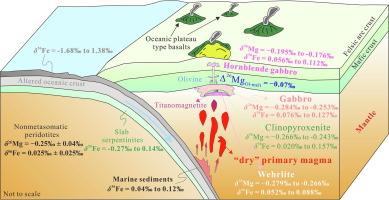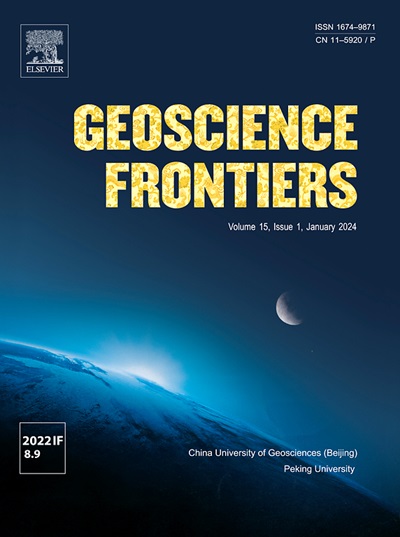弧岩浆演化:来自东昆仑基性-超基性岩镁铁同位素的启示
IF 8.9
1区 地球科学
Q1 GEOSCIENCES, MULTIDISCIPLINARY
引用次数: 0
摘要
镁铁质-超镁铁质岩石中镁铁同位素变化的成因一直争论不休。特别是,对于弧岩浆中Mg和Fe同位素组成的变化与分馏结晶的关系,目前还缺乏认识。本文报道了东昆仑造山带岩浆共生演化形成的基性-超基性岩石的镁铁同位素分析。超镁质和辉长岩样品的Mg同位素组成呈幔状,辉长岩的δ26Mg值为- 0.279‰~ - 0.266‰,斜辉长岩的δ26Mg值为- 0.266‰~ - 0.243‰,辉长岩的δ26Mg值为- 0.284‰~ - 0.253‰。角闪石辉长岩样品的δ26Mg值明显偏高(- 0.195‰~ - 0.176‰)。这些岩石具有相似的重铁同位素组成,δ56Fe值在0.020‰~ 0.157‰之间。角闪石辉长岩中较高的δ26Mg值解释为橄榄石分馏最多6%,而斜辉石岩中略高的δ26Mg值归因于钛磁铁矿的富集。这些岩石的铁同位素特征继承自岩浆源。与其他基性-超基性岩石的对比表明,海相沉积物熔体交代作用引起的地幔楔的部分熔融可产生“干”弧岩浆活动,这需要在进一步的研究中进行更全面和详细的分析。本文章由计算机程序翻译,如有差异,请以英文原文为准。

Arc magma evolution: Insights from magnesium and iron isotope in mafic–ultramafic rocks, Eastern Kunlun, NW China
The origin of magnesium and iron isotope variations in mafic–ultramafic rocks has long been debated. In particular, a substantial lack of understanding exists regarding how the variation in the Mg and Fe isotopic compositions of arc magmas relates to fractional crystallization. Here, we report new Mg and Fe isotopic analyses of mafic–ultramafic rocks formed by co-genetic magmatic evolution in the Eastern Kunlun orogenic belt. The ultramafic and gabbro samples present mantle-like Mg isotopic compositions, with δ26Mg values ranging from −0.279‰ to −0.266‰ for wehrlite, −0.266‰ to −0.243‰ for clinopyroxenite, and −0.284‰ to −0.253‰ for gabbro. In contrast, the δ26Mg values of the hornblende gabbro samples are significantly higher (−0.195‰ to −0.176‰). These rocks have similar heavy Fe isotopic compositions, with δ56Fe values ranging from 0.020‰ to 0.157‰. The high δ26Mg values observed in the hornblende gabbro are interpreted as indicating a maximum of 6% olivine fractionation, whereas the slightly high δ26Mg values in the clinopyroxenite are ascribed to the accumulation of titanomagnetite. The Fe isotopic signatures of these rocks are inherited from magmatic sources. A comparison of the studied rocks with other mafic-ultramafic rocks implies that partial melting of mantle wedges induced by metasomatism of marine sediment-derived melts could generate “dry” arc magmatism, which would necessitate a more comprehensive and detailed analysis in further investigations.
求助全文
通过发布文献求助,成功后即可免费获取论文全文。
去求助
来源期刊

Geoscience frontiers
Earth and Planetary Sciences-General Earth and Planetary Sciences
CiteScore
17.80
自引率
3.40%
发文量
147
审稿时长
35 days
期刊介绍:
Geoscience Frontiers (GSF) is the Journal of China University of Geosciences (Beijing) and Peking University. It publishes peer-reviewed research articles and reviews in interdisciplinary fields of Earth and Planetary Sciences. GSF covers various research areas including petrology and geochemistry, lithospheric architecture and mantle dynamics, global tectonics, economic geology and fuel exploration, geophysics, stratigraphy and paleontology, environmental and engineering geology, astrogeology, and the nexus of resources-energy-emissions-climate under Sustainable Development Goals. The journal aims to bridge innovative, provocative, and challenging concepts and models in these fields, providing insights on correlations and evolution.
 求助内容:
求助内容: 应助结果提醒方式:
应助结果提醒方式:


